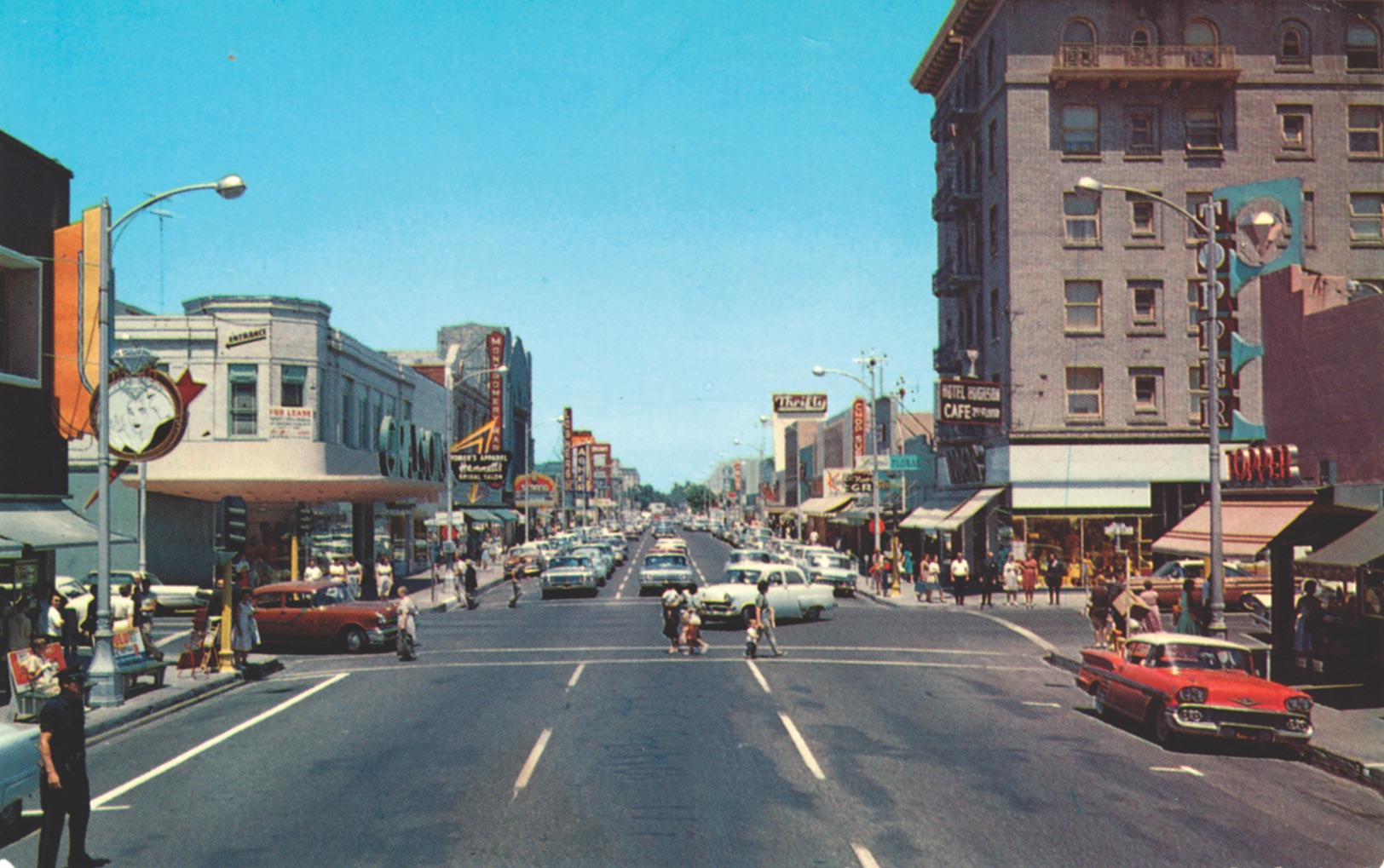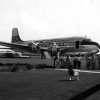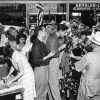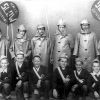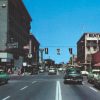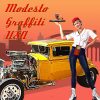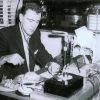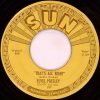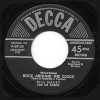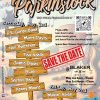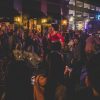A Decade of Optimism, Growth, and Prosperity
By Ken White
Let’s rewind to a valley not so far away, not so long ago. To a nostalgic decade when the world was simpler, Ike was president, the music sweeter, and cruising was king. It was an innocent time in Modesto. Native-son George Lucas described it as a “Norman Rockwell” town. At least it seemed that way in the wake of the world war.
Downtown
Like the rest of the country, Modesto enjoyed unprecedented post-war optimism, growth, and prosperity.
For downtown Modesto, the Fifties were a decade of expansion. The population doubled and the town grew rapidly. Downtown was still the primary shopping area. However, for the first time, businesses began to leave the downtown core for suburban locations along J Street and McHenry Avenue, which until then had been mostly residential. In October 1953, McHenry Village Shopping Center opened. With 18 stores and services, it was the largest retail development until that time.
The Arts
For the Arts, the Fifties were an exceptional decade. Although Modesto was known primarily for its agricultural output, it was also home to a vibrant arts community. The Community Concert Association was founded in 1950, the Central California Art League in 1952. In October 1954, the 1,500 seat Mancini Music Bowl was dedicated with 3,000 citizens in attendance.
Community
For the community at large, the Fifties were an energetic decade.
In the early 1950s, a group of African-American families started the Monterey Park Tract community west of town. In October 1952, Richard M. Nixon made a second visit to Modesto to speak at Courthouse Park while running for vice president. In 1954, Stanislaus County celebrated its 100-year anniversary with a week-long celebration centered on the theme, “100 Years of Progress and Prosperity.” That same year, Modesto received its first All-America City Award.
Government
For Government, the Fifties were an exciting decade.
In 1951, a revised version of the 1949 city charter was ratified by the voters. It established a city manager form of government. In 1953, Modestan Ralph M. Brown, who represented the 30th Assembly District and was Speaker of the Assembly, authored the Brown Act, which provided increased public access to government meetings.
Entertainment, Recreation & Sports
For Entertainment, Recreation & Sports, the Fifties were an extraordinarydecade.
A news story of the time hinted at the active tradition of sports in Modesto. It read, “practically any type of sport you wish to take part in or witness may be found in Modesto and its surrounding territory.” Initiated by the Women’s Improvement Club, the city’s park system continued to expand. It was also during this time that the city built on its reputation as the “City of Trees.”
Planning for the city’s second golf facility, the Dryden Park Municipal Golf Course, was launched in 1954 when Horace and Dorothy Dryden donated 60 acres of land along the Tuolumne River. Along with Tom Moore and Tom Mellis, Fred Earle launched the Northern California Relays, later called the Modesto Relays, which began in 1942.
Community baseball dated back to Modesto’s beginnings. In the Fifties, the minor League Modesto Reds were a farm club for the Pittsburgh Pirates (1949-1952), Milwaukee Braves (1953), and New York Yankees (1954-1961).
The first private swim-tennis club, called the Modesto Racquet Club, was built by Fred Earle in 1957. Another private athletic club, the SOS (Sportsmen of Stanislaus) Club, also started in 1957.
A primary entertainment option in this decade remained AM radio. KTRB, KFIV, and KBEE were all broadcasting music, news, and sports.
Education
For education, it was an enlightening decade.
With the baby boom that followed the war, there was an urgent need for additional schools, resulting in the construction of twelve new schools in seven years. Modesto was a one-high-school town for 70 years. Downey High School opened in 1951 with 650 pupils. It was named after Thomas Downey, who was principal at both the old and new Modesto High.
Healthcare
For healthcare, the 1950s were an eventful decade.
More citizens spurred the growth of more healthcare facilities. In 1951, Memorial Hospital South opened in Ceres. The Stanislaus County Hospital and Almshouse, a stately Victorian structure erected in 1891, was torn down in 1950 to make room for the new Scenic General, a modern and efficient hospital.
Architecture
For architecture, the 1950s were an eclectic decade.
In the mid-twentieth century, Modesto became an architecture laboratory where both local and nationally known architects experimented with a new architectural style. They adapted European Modernism to the local climate and created Central Valley Modernism. Demolition of the historic Stanislaus County Courthouse, which had been built in 1872 and expanded in 1901, began in early 1958.
Business
In business, the decade of the Fifties was explosive.
In 1952, brothers-in-law Mike Piccinini and Nick Tocco opened their first Save Mart Supermarket in Modesto on Crows Landing Road. Construction of an expanded airport began in 1956. To accommodate the new generation of planes, it was necessary to acquire more acreage to construct a new 5,000 foot parallel runway and taxiway. In 1959, Jerry Marsh, who had built Modesto Bowl, teamed up with Art Sanders of Sanders Construction to build the twenty-four lane McHenry Bowl, which was an incredible two miles outside of town. The winery founded by Ernest and Julio Gallo continued to prosper and grow on their way to becoming the world’s largest.
The Graffiti Decade
The Fifties were the decade that established Modesto as the home of the car and cruising culture.
The Film
Throughout the ‘50s, “draggin’” 10th Street was the popular pastime for Modesto’s teenagers. This resulted in hometown hero George Lucas’ 1973 film American Graffiti that asked the question, “Where Were You in ‘62?” The film launched a world-wide resurgence of retro ’50s and ’60s culture, reintroducing the cars, the cruise, the customizers, the car clubs, the drive-ins, and the music to a world ready for small town authenticity.
The Cruise
The name “draggin’ Tenth” originated in Modesto as drivers would drag race from one traffic light to the next on Tenth Street. The original cruise route started at Burge’s Drive-in on Ninth Street, which was also Highway 99, and O Street, up to Tenth, a right, out Tenth, then a turnaround at the Modesto Fire Station block between F and G Streets, back down Tenth, a left on O, and back to Burge’s.
The Car Customizers
Modesto became home to some of the most legendary street rod builders and car customizers. The kings of the kustomizers included Gene Winfield, Marvin “Bart” Bartoni, and Pete Hischier.
The Car Clubs
Both the car guys and the motorcycle dudes formed clubs. Two of the first car clubs in Modesto were the 36’ers and the Century Toppers.
The Drive-Ins
In Modesto during the Fifties, drive-ins like Burge’s werewhere it was happening. Following the opening of Thomas Downey High School in 1951, Downey students adopted Al’s and Felix’s Drive-ins on McHenry.
The Music
Music had always been a big part of Modesto history. The Maddox Brothers and Rose helped forge the rockabilly style that paved the way for the rock ‘n’ roll bands that followed. Early local rock bands like Kent Whitt & the Downbeats with Roddy Jackson and Jim Burgett played at the California Ballroom, Playland and others.
As the teenagers dragged Tenth, KFIV-1360 AM would play the popular songs of the day. Boys and girls purchased the records they heard on the radio at Harley’s Records, located at 1218 J Street. North and across the street, there was another store simply called “Records” at 14th and J.
End of the Decade
With the close of the Fifties and the dawning of the Sixties, Modesto waved goodbye to innocence and smiled hello to turbulence.
(Do-do-do-do-do)
Goodnight, sweetheart, well it’s time to go,
(Ba-do ba-do)
I hate to leave you, but I really must say,
Goodnight, sweetheart, goodnight.


